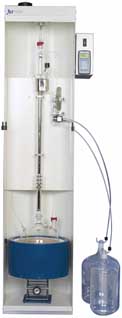9600 and 800 Theoretical Plate Study
In order to determine the number of plates in a given distillation apparatus, it is necessary to operate the still at TOTAL REFLUX. While distillations are actually carried out at only partial reflux (material is removed from the still during distillation), it is generally assumed that the number of plates achieved at total reflux is indicative of the type of separation that can be achieved by a given distillation unit.
EXPERIMENTAL TEST
In order to ascertain the number of plates for a 9600 distillation system, a mixture of 80 % Methylcyclohexane and 20 % Heptane is used. These materials also must be purified before use and must contain less than 0.1 % contaminants based on GC analysis. The 9600 distillation unit is cleaned with pure Hexane before use and purged with dry Nitrogen for several hours. The pot flask is charged with 500 grams of the Methylcyclohexane/Heptane mixture, Teflon boiling chips are added, and the reflux valve pushed down into the valve seat in order to minimize leakage during the experiment. The condenser water is cooled to 0 o C. Heating is begun and after reflux is attained, the band is turned on. Samples (2 – 4 drops) are removed just after Boil-up is reached, at two hours, and at 23 hours. This is accomplished by manually raising the reflux valve magnet with a hand held magnet. After each sample is taken, the reflux valve is forced down in order to prevent leakage. The samples are then analyzed by Gas Chromatographic Analysis using an FID Detector and the appropriate calibration curve. The number of THEORETICAL PLATES are then calculated from the FENSKE EQUATION below. a for the Methylcyclohexane/Heptane mixture is 1.0760.
COMMON MISTAKES
It is easy to make critical mistakes when performing a plate study. The most common error is using Heptane or Methylcyclohexane that is not of the required purity. These materials must have less than 0.1 % contamination when analyzed by GC. Small amounts of impurities lead to enormous errors in a plate study. Another common mistake is loss of material during the study. This leads to constantly changing composition of the mixture and erroneous results.
BOIL-UP RATES AND THEIR EFFECT ON PLATE NUMBERS
Boil-up rates have a strong effect on the number of theoretical plates. Lower Boil-up rates lead to higher number of plates. It is important to maintain the desired Boil-up rate throughout the equilibration before samples are removed. Changing Boil-up rates just before taking a sample will lead to erroneous results.
BAND SPEEDS AND THEIR EFFECT ON PLATE NUMBERS
Band speed has a strong correlation with the number of theoretical plates. In general, higher speeds give a higher number of plates. Of course, there is a practical limit to the maximum speed that the band can be rotated in a column.
BAND TYPES
There are two types of spinning bands: Teflon and Metal. Teflon bands produce higher number of theoretical plates than metal bands. This is the result of the different geometry and construction of the bands and the fact that metal bands must be rotated at slower speeds.

